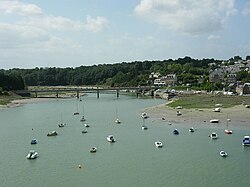|
Arguenon
The Arguenon (French pronunciation: [aʁɡənɔ̃]; Breton: Argenon) is a French coastal river in the Côtes-d'Armor department of the Brittany region. It flows into the English Channel. Geography The length of the watercourse is 53.4 kilometres (33.2 mi).[1][2][a] The river rises in the commune of Le Gouray in Côtes-d'Armor and flows into the sea near Saint-Jacut-de-la-Mer, in the commune of Créhen, in the Bay of Arguenon.[3] The Arguenon is very wide between Jugon-les-Lacs and Plorec-sur-Arguenon. The Ville-Hatte dam built in 1972 to supply the department with drinking water has created a water reservoir more than 10 kilometres (6.2 mi) long named Lac d'Arguenon. The Arguenon runs northeast from its source to Jugon-les-Lacs, north between Jugon-les-Lacs and Plorec-sur-Arguenon, northeast again between Plorec-sur-Arguenon and Plancoët and north-northeast from Plancoët to its mouth. During high tides a small tidal bore rises up the river, up to the height of the Guildo bridge. Communes and cantons crossedThe Arguenon's course is entirely within the Côtes-d'Armor department. It crosses twelve communes, from upstream to downstream: Le Gouray (source), Plénée-Jugon, Dolo, Jugon-les-Lacs, Plorec-sur-Arguenon, Plédéliac, Pléven, Bourseul, Pluduno, Plancoët, Saint-Lormel, Créhen and Saint-Cast-le-Guildo (mouth).[1] Managing bodyThe managing body is SAGE Arguenon – Baie de la Fresnaye.[4] TributariesThe Arguenon has four named tributary streams, one river and 10 unnamed tributaries including:[1]
We can also add, according to the National Institute of Geographic and Forest Information or Géoportail, and since the Guébriand is not a river in its own right:
HydrologyArguenon at Jugon-les-LacsThe Arguenon has been observed in Jugon-les-Lacs since 1972 at station J1103010 L'Arguenon, at an altitude of 31 metres (102 ft) with a catchment area of 104 kilometres (64.62 mi).[5] The annual average of its flow at this point is 0.829 cubic metres per second (29.3 cu ft/s).[5]
Low waterAt low water the minimum flow rate of the watercourse recorded for three consecutive days in a month, during a five-year dry period, was 0.014 cubic metres per second (0.49 cu ft/s).[5] Floods During the observation period, the maximum daily flow was observed on 28 February 2010 at 24.80 cubic metres per second (876 cu ft/s). The maximum instantaneous flow (QIX: quantité instantanée maximale) was observed at 14:21 on 28 February 2010 was 36.10 cubic metres per second (1,275 cu ft/s), and at the same time the instantaneous maximum height was 217 centimetres (85 in).[5] The 10-year QIX is 23 cubic metres per second (810 cu ft/s), the 20-year QIX is 28 cubic metres per second (990 cu ft/s) and the 50-year QIX is 34 cubic metres per second (1,200 cu ft/s) while the 2-year QIX is 11 cubic metres per second (390 cu ft/s) and the 5-year QIX is 18 cubic metres per second (640 cu ft/s).[5] The Arguenon has experienced several significant floods. The first took place in 1974. The water overflowed 1 metre (3 ft 3 in) on the Plancoët quay, causing major and widespread damage. The second took place in 2010, this time with 50 centimetres (20 in) on the quayside. The floodwater affected a lot of businesses. The last took place in February 2014, with 1.45 metres (4 ft 9 in) on the quays. Shops were closed permanently and a park was completely flooded. Depth of runoff and specific flowThe depth of runoff in this part of the river's catchment area is 253 millimetres (10.0 in) annually, which is a little lower than the average in France. The specific flow rate reaches 8.0 litres per second (106 imp gal/min) per 1 square kilometre (0.39 sq mi) of basin.[5] Facilities and ecologyThe Arguenon is crossed by Route nationale 176 and Route nationale 12. The Arguenon estuary is protected by a 381 hectares (940 acres) Zone naturelle d'intérêt écologique, faunistique et floristique.[6] Arguenon Bay is part of the Natura 2000 zone Lancieux Bay, Arguenon Bay, Saint Malo and Dinard Archipelago.[7] NotesCitationsSources
|
|||||||||||||||||||||||||||||||||||||||||||||||||||
Portal di Ensiklopedia Dunia




